Abstract
We studied the contribution of carotid vs. extracarotid baroreceptors in control of heart rate in normal humans. We measured heart interval (HI) and arterial pressure during steady-state infusion of phenylephrine (PE). PE increased mean arterial pressure (MAP) by 13 +/- 2 mmHg (mean +/- SEM; n = 10) and thus stimulated both carotid and aortic baroreceptors. Neck pressure (NP) was applied during PE infusion to counter the increase in transmural carotid sinus pressure, thus leaving only aortic baroreceptors stimulated by the increase in arterial pressure. PE infusion alone prolonged HI by 230 +/- 24 ms (P less than 0.05). Application of NP attenuated the HI response to 65 +/- 22 ms above control (P less than 0.05 vs. PE alone). During these steady-state increases in arterial pressure, elimination of the carotid baroreflex contribution reduced the HI prolongation by 41-70% in five subjects and by greater than 93% in five subjects. We also measured the HI response to dynamic ramp elevation of systolic arterial pressure (SAP) using bolus administrations of PE. Baroreflex control was calculated from the slope of the regression correlating SAP to succeeding HI for PE alone (carotid and aortic baroreceptor activation) and for PE plus superimposed dynamic NP at levels equal to the increases in SAP (aortic baroreceptor activation). During PE alone, the baroreflex slope was 20.2 +/- 2.9 ms/mmHg (n = 10). During PE plus NP, the baroreflex slope was reduced by 30% to 14.1 +/- 2.8 ms/mmHg (P less than 0.02 vs. during PE alone). Thus, during dynamic increases in arterial pressure, eliminating the carotid baroreflex contribution reduced the HI response by 30%. These studies indicate that extracarotid (presumably aortic) and carotid baroreflexes both participate in control of heart rate in humans. Extracarotid (aortic) baroreflexes appear to have the greater role in control of heart rate during dynamic increases in arterial pressure.
Full text
PDF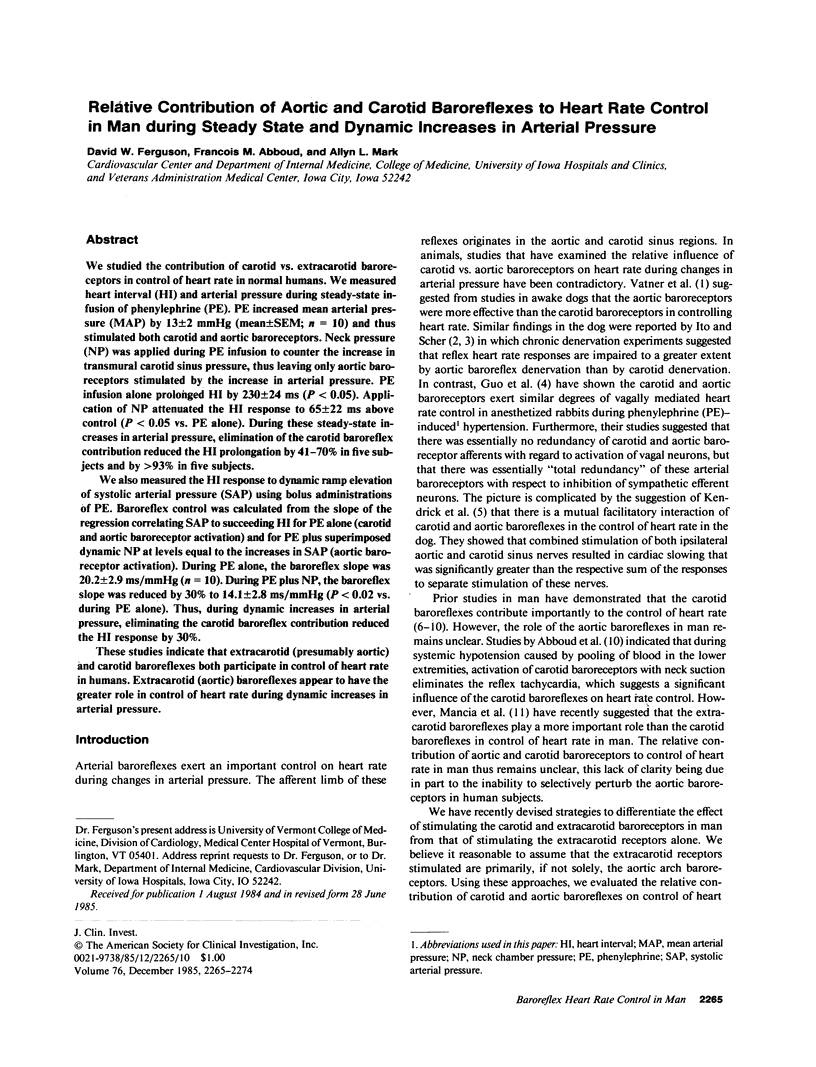
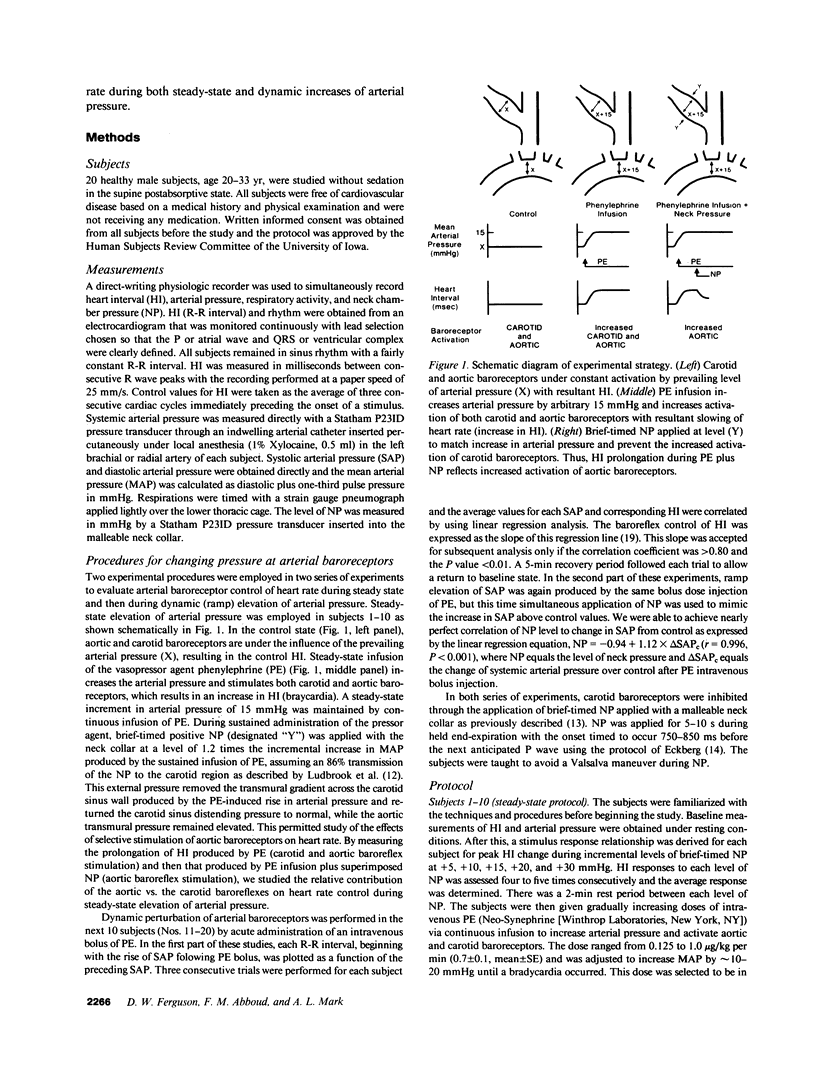
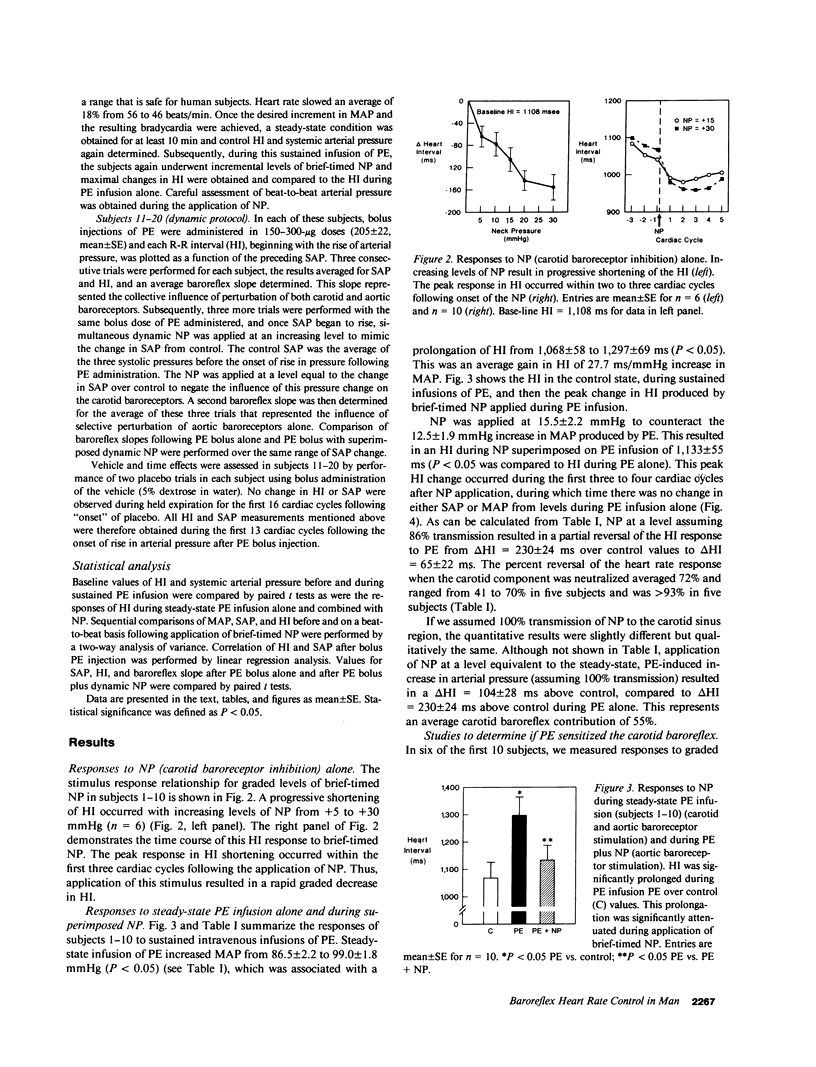
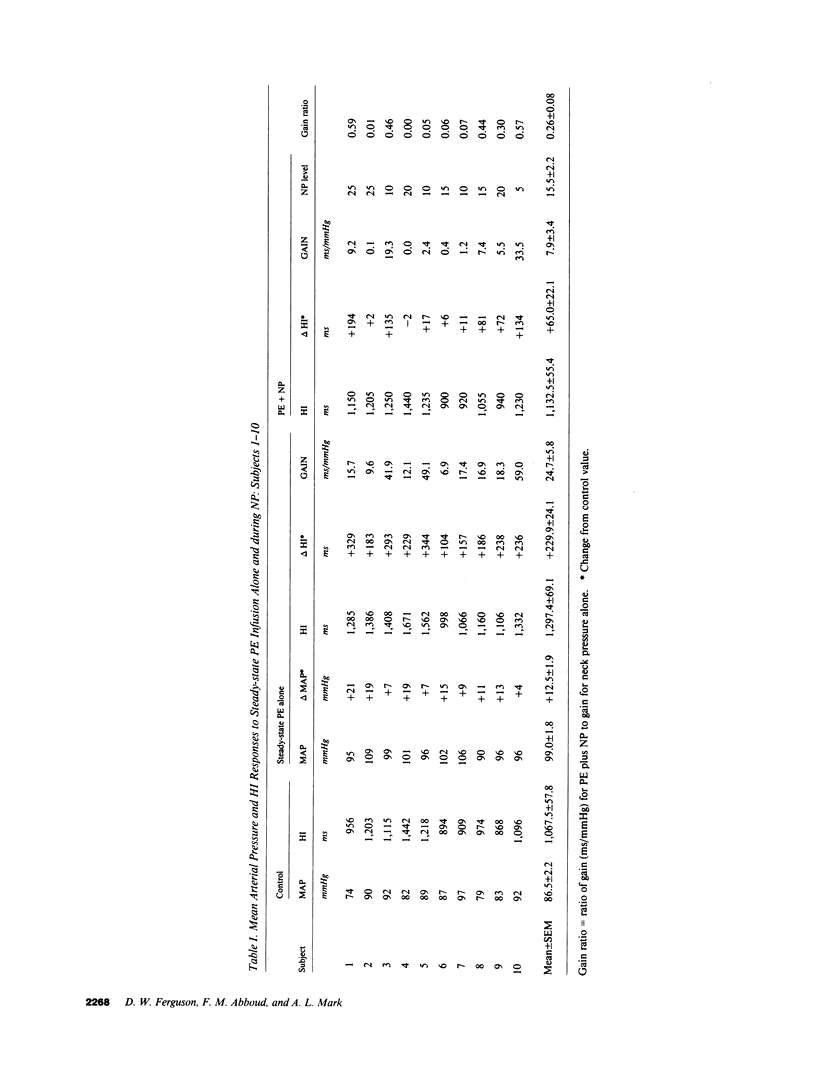
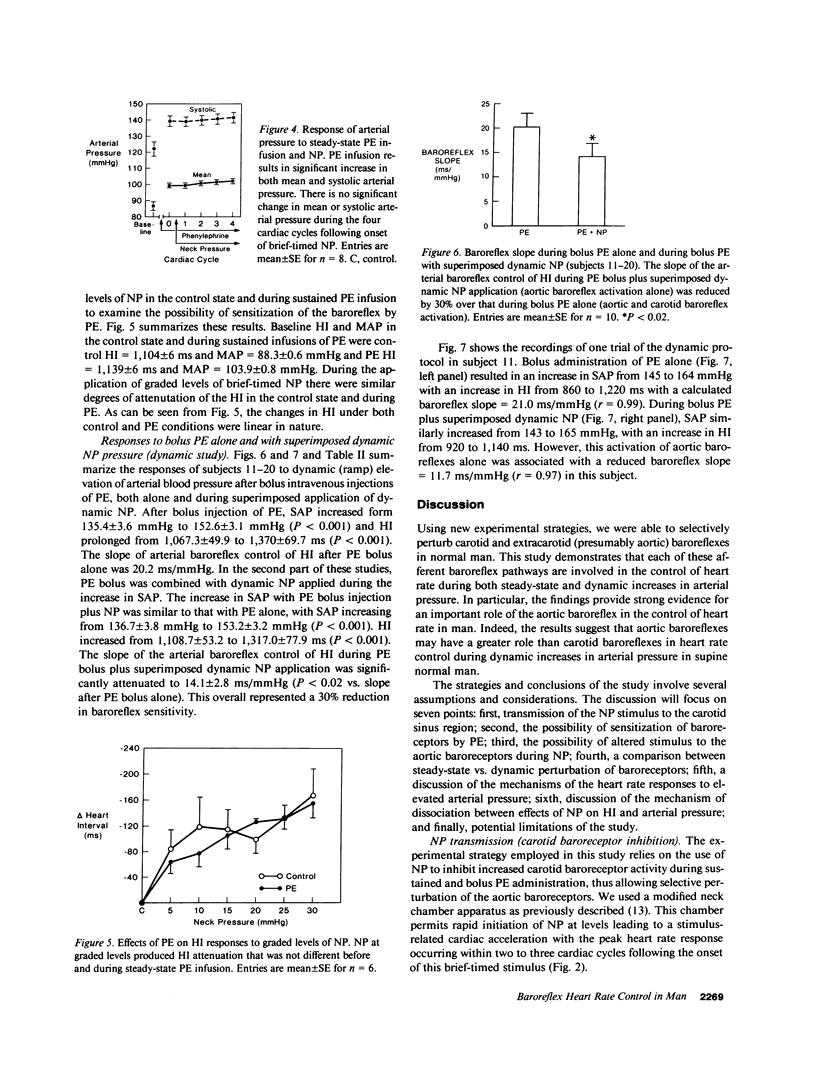
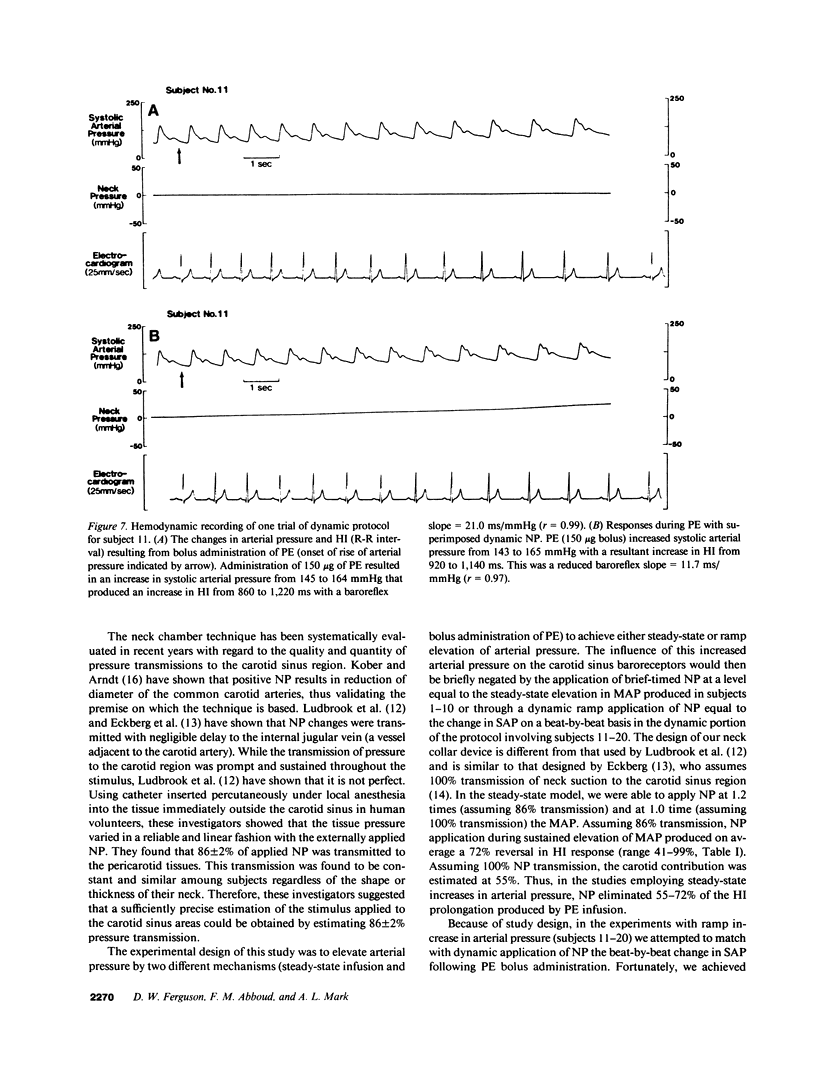
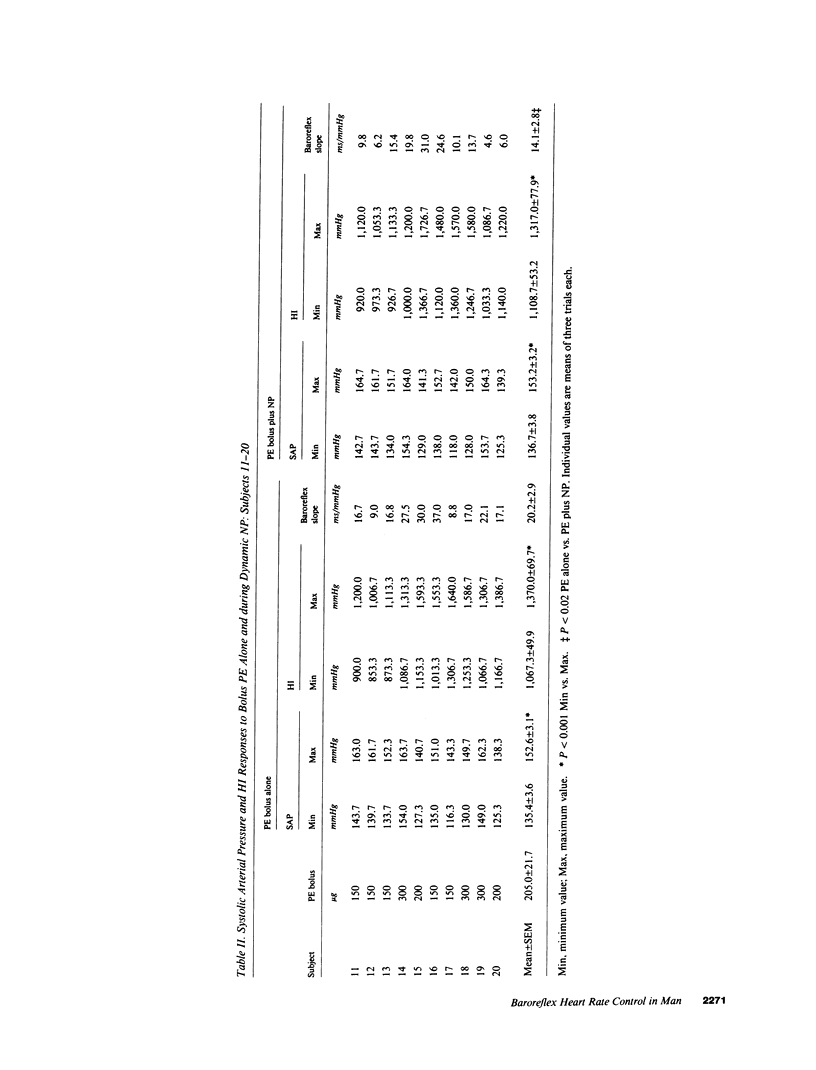
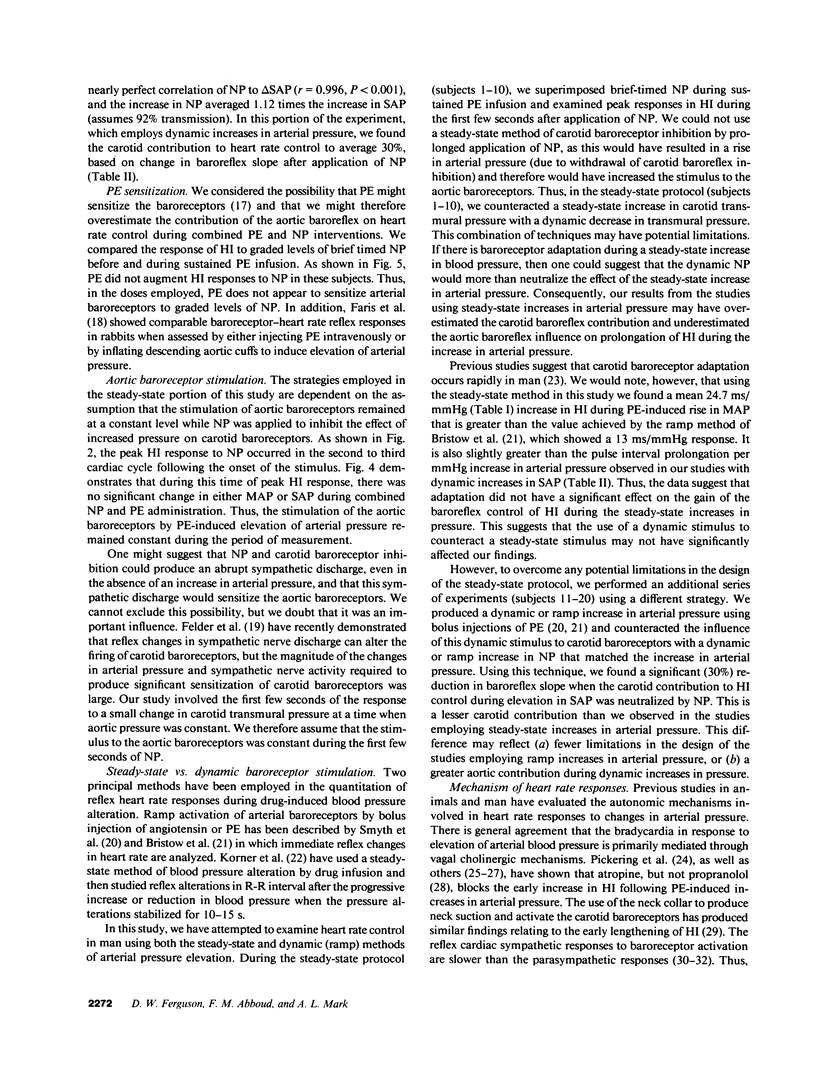
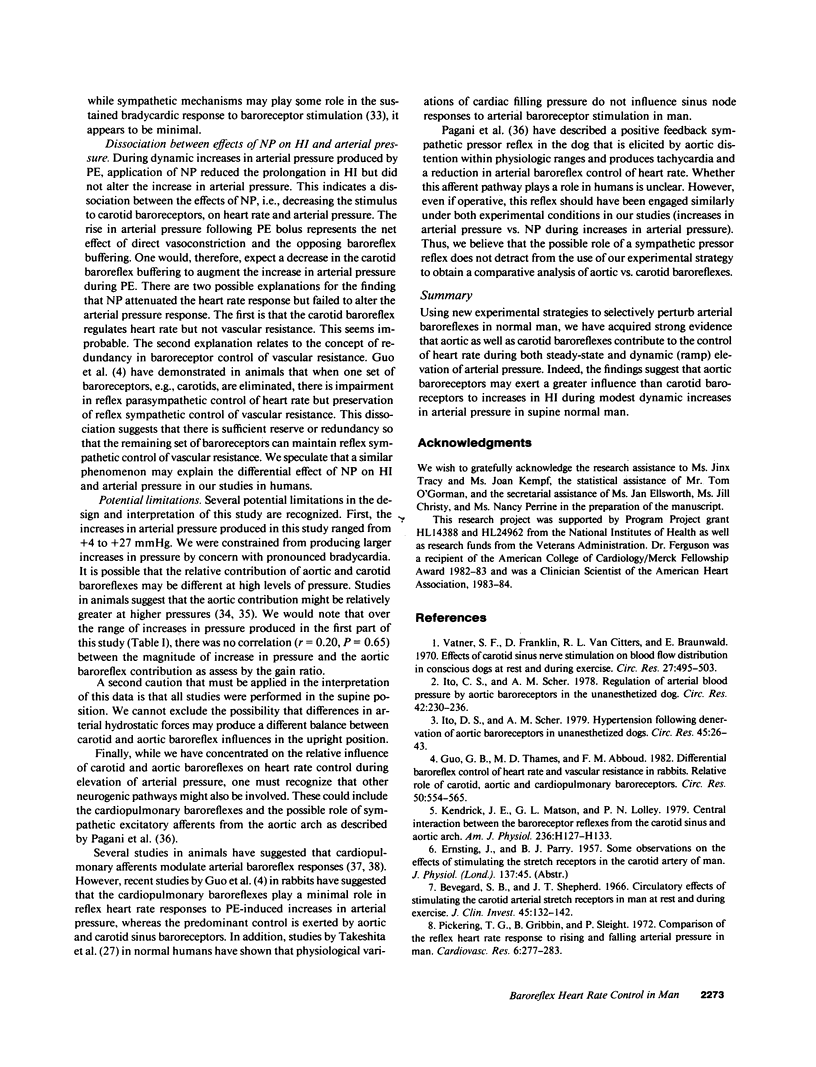
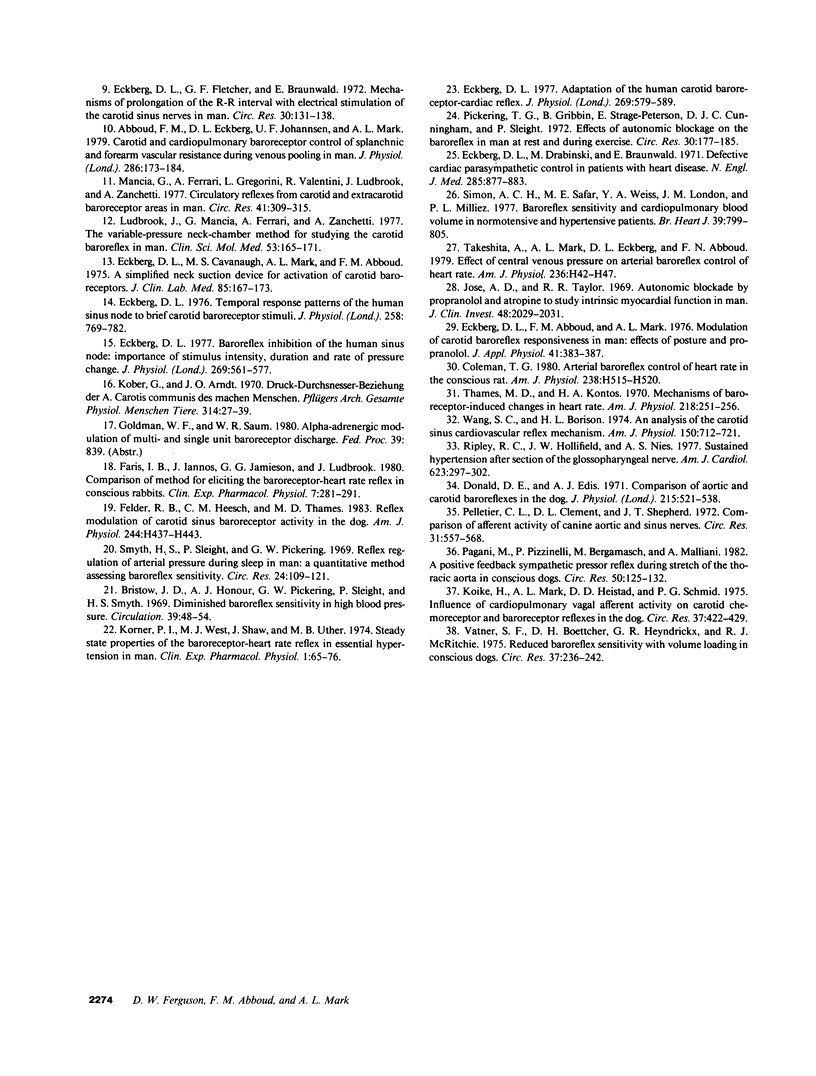
Selected References
These references are in PubMed. This may not be the complete list of references from this article.
- Abboud F. M., Eckberg D. L., Johannsen U. J., Mark A. L. Carotid and cardiopulmonary baroreceptor control of splanchnic and forearm vascular resistance during venous pooling in man. J Physiol. 1979 Jan;286:173–184. doi: 10.1113/jphysiol.1979.sp012612. [DOI] [PMC free article] [PubMed] [Google Scholar]
- Bevegård B. S., Shepherd J. T. Circulatory effects of stimulating the carotid arterial stretch receptors in man at rest and during exercise. J Clin Invest. 1966 Jan;45(1):132–142. doi: 10.1172/JCI105317. [DOI] [PMC free article] [PubMed] [Google Scholar]
- Bristow J. D., Honour A. J., Pickering G. W., Sleight P., Smyth H. S. Diminished baroreflex sensitivity in high blood pressure. Circulation. 1969 Jan;39(1):48–54. doi: 10.1161/01.cir.39.1.48. [DOI] [PubMed] [Google Scholar]
- Coleman T. G. Arterial baroreflex control of heart rate in the conscious rat. Am J Physiol. 1980 Apr;238(4):H515–H520. doi: 10.1152/ajpheart.1980.238.4.H515. [DOI] [PubMed] [Google Scholar]
- Donald D. E., Edis A. J. Comparison of aortic and carotid baroreflexes in the dog. J Physiol. 1971 Jun;215(2):521–538. doi: 10.1113/jphysiol.1971.sp009483. [DOI] [PMC free article] [PubMed] [Google Scholar]
- Eckberg D. L., Abboud F. M., Mark A. L. Modulation of carotid baroreflex responsiveness in man: effects of posture and propranolol. J Appl Physiol. 1976 Sep;41(3):383–387. doi: 10.1152/jappl.1976.41.3.383. [DOI] [PubMed] [Google Scholar]
- Eckberg D. L. Adaptation of the human carotid baroreceptor-cardiac reflex. J Physiol. 1977 Aug;269(3):579–589. doi: 10.1113/jphysiol.1977.sp011916. [DOI] [PMC free article] [PubMed] [Google Scholar]
- Eckberg D. L. Baroreflex inhibition of the human sinus node: importance of stimulus intensity, duration, and rate of pressure change. J Physiol. 1977 Aug;269(3):561–577. doi: 10.1113/jphysiol.1977.sp011915. [DOI] [PMC free article] [PubMed] [Google Scholar]
- Eckberg D. L., Cavanaugh M. S., Mark A. L., Abboud F. M. A simplified neck suction device for activation of carotid baroreceptors. J Lab Clin Med. 1975 Jan;85(1):167–173. [PubMed] [Google Scholar]
- Eckberg D. L., Drabinsky M., Braunwald E. Defective cardiac parasympathetic control in patients with heart disease. N Engl J Med. 1971 Oct 14;285(16):877–883. doi: 10.1056/NEJM197110142851602. [DOI] [PubMed] [Google Scholar]
- Eckberg D. L., Fletcher G. F., Braunwald E. Mechanism of prolongation of the R-R interval with electrical stimulation of the carotid sinus nerves in man. Circ Res. 1972 Jan;30(1):131–138. doi: 10.1161/01.res.30.1.131. [DOI] [PubMed] [Google Scholar]
- Eckberg D. L. Temporal response patterns of the human sinus node to brief carotid baroreceptor stimuli. J Physiol. 1976 Jul;258(3):769–782. doi: 10.1113/jphysiol.1976.sp011445. [DOI] [PMC free article] [PubMed] [Google Scholar]
- Faris I. B., Iannos J., Jamieson G. G., Ludbrook J. Comparison of methods for eliciting the baroreceptor-heart rate reflex in conscious rabbits. Clin Exp Pharmacol Physiol. 1980 May-Jun;7(3):281–291. doi: 10.1111/j.1440-1681.1980.tb00072.x. [DOI] [PubMed] [Google Scholar]
- Felder R. B., Heesch C. M., Thames M. D. Reflex modulation of carotid sinus baroreceptor activity in the dog. Am J Physiol. 1983 Mar;244(3):H437–H443. doi: 10.1152/ajpheart.1983.244.3.H437. [DOI] [PubMed] [Google Scholar]
- Guo G. B., Thames M. D., Abboud F. M. Differential baroreflex control of heart rate and vascular resistance in rabbits. Relative role of carotid, aortic, and cardiopulmonary baroreceptors. Circ Res. 1982 Apr;50(4):554–565. doi: 10.1161/01.res.50.4.554. [DOI] [PubMed] [Google Scholar]
- Ito C. S., Scher A. M. Hypertension following denervation of aortic baroreceptors in unanesthetized dogs. Circ Res. 1979 Jul;45(1):26–34. doi: 10.1161/01.res.45.1.26. [DOI] [PubMed] [Google Scholar]
- Ito C. S., Scher A. M. Regulation of arterial blood pressure by aortic baroreceptors in the unanesthetized dog. Circ Res. 1978 Feb;42(2):230–236. doi: 10.1161/01.res.42.2.230. [DOI] [PubMed] [Google Scholar]
- Jose A. D., Taylor R. R. Autonomic blockade by propranolol and atropine to study intrinsic myocardial function in man. J Clin Invest. 1969 Nov;48(11):2019–2031. doi: 10.1172/JCI106167. [DOI] [PMC free article] [PubMed] [Google Scholar]
- Kober G., Arndt J. O. Die Druck-Durchmesser-Beziehung der A. carotis communis des wachen Menschen. Pflugers Arch. 1970;314(1):27–39. doi: 10.1007/BF00587044. [DOI] [PubMed] [Google Scholar]
- Koike H., Mark A. L., Heistad D. D., Schmid P. G. Influence of cardiopulmonary vagal afferent activity on carotid chemoreceptor and baroreceptor reflexes in the dog. Circ Res. 1975 Oct;37(4):422–429. doi: 10.1161/01.res.37.4.422. [DOI] [PubMed] [Google Scholar]
- Korner P. I., West M. J., Shaw J., Uther J. B. "Steady-state" properties of the baroreceptor-heart rate reflex in essential hypertension in man. Clin Exp Pharmacol Physiol. 1974 Jan-Feb;1(1):65–76. doi: 10.1111/j.1440-1681.1974.tb00528.x. [DOI] [PubMed] [Google Scholar]
- Ludbrook J., Mancia G., Ferrari A., Zanchetti A. The variable-pressure neck-chamber method for studying the carotid baroreflex in man. Clin Sci Mol Med. 1977 Aug;53(2):165–171. doi: 10.1042/cs0530165. [DOI] [PubMed] [Google Scholar]
- Mancia G., Ferrari A., Gregorini L., Valentini R., Ludbrook J., Zanchetti A. Circulatory reflexes from carotid and extracarotid baroreceptor areas in man. Circ Res. 1977 Sep;41(3):309–315. doi: 10.1161/01.res.41.3.309. [DOI] [PubMed] [Google Scholar]
- Pagani M., Pizzinelli P., Bergamaschi M., Malliani A. A positive feedback sympathetic pressor reflex during stretch of the thoracic aorta in conscious dogs. Circ Res. 1982 Jan;50(1):125–132. doi: 10.1161/01.res.50.1.125. [DOI] [PubMed] [Google Scholar]
- Pelletier C. L., Clement D. L., Shepherd J. T. Comparison of afferent activity of canine aortic and sinus nerves. Circ Res. 1972 Oct;31(4):557–568. doi: 10.1161/01.res.31.4.557. [DOI] [PubMed] [Google Scholar]
- Pickering T. G., Gribbin B., Petersen E. S., Cunningham D. J., Sleight P. Effects of autonomic blockade on the baroreflex in man at rest and during exercise. Circ Res. 1972 Feb;30(2):177–185. doi: 10.1161/01.res.30.2.177. [DOI] [PubMed] [Google Scholar]
- Pickering T. G., Gribbin B., Sleight P. Comparison of the reflex heart rate response to rising and falling arterial pressure in man. Cardiovasc Res. 1972 May;6(3):277–283. doi: 10.1093/cvr/6.3.277. [DOI] [PubMed] [Google Scholar]
- Ripley R. C., Hollifield J. W., Nies A. S. Sustained hypertension after section of the glossopharyngeal nerve. Am J Med. 1977 Feb;62(2):297–302. doi: 10.1016/0002-9343(77)90326-6. [DOI] [PubMed] [Google Scholar]
- Simon A. C., Safar M. E., Weiss Y. A., London G. M., Milliez P. L. Baroreflex sensitivity and cardiopulmonary blood volume in normotensive and hypertensive patients. Br Heart J. 1977 Jul;39(7):799–805. doi: 10.1136/hrt.39.7.799. [DOI] [PMC free article] [PubMed] [Google Scholar]
- Smyth H. S., Sleight P., Pickering G. W. Reflex regulation of arterial pressure during sleep in man. A quantitative method of assessing baroreflex sensitivity. Circ Res. 1969 Jan;24(1):109–121. doi: 10.1161/01.res.24.1.109. [DOI] [PubMed] [Google Scholar]
- Takeshita A., Mark A. L., Eckberg D. L., Abboud F. M. Effect of central venous pressure on arterial baroreflex control of heart rate. Am J Physiol. 1979 Jan;236(1):H42–H47. doi: 10.1152/ajpheart.1979.236.1.H42. [DOI] [PubMed] [Google Scholar]
- Thames M. D., Kontos H. A. Mechanisms of baroreceptor-induced changes in heart rate. Am J Physiol. 1970 Jan;218(1):251–256. doi: 10.1152/ajplegacy.1970.218.1.251. [DOI] [PubMed] [Google Scholar]
- Vatner S. F., Boettcher D. H., Heyndrickx G. R., McRitchie R. J. Reduced baroreflex sensitivity with volume loading in conscious dogs. Circ Res. 1975 Aug;37(2):236–242. doi: 10.1161/01.res.37.2.236. [DOI] [PubMed] [Google Scholar]
- Vatner S. F., Franklin D., Van Citters R. L., Braunwald E. Effects of carotid sinus nerve stimulation on blood-flow distribution in conscious dogs at rest and during exercise. Circ Res. 1970 Oct;27(4):495–503. doi: 10.1161/01.res.27.4.495. [DOI] [PubMed] [Google Scholar]


